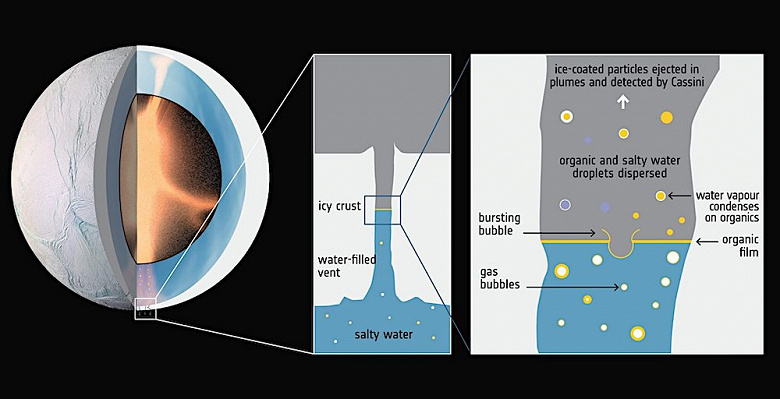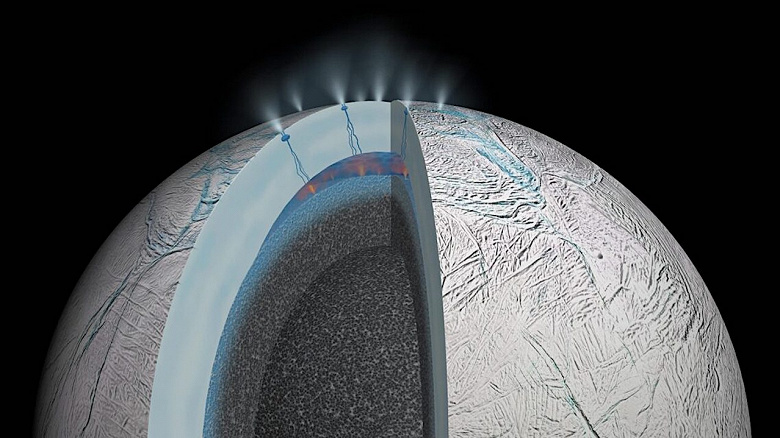Upgraded interplanetary missions – an open path to evidence of extraterrestrial life on the icy oceans of Saturn and Jupiter
Icy oceans on some of the moons of Saturn and Jupiter, which are covered in ice, — the main candidates for the search for extraterrestrial life. New research from the University of Washington in Seattle and the Freie Universität Berlin shows that individual ice «grains» may contain enough material for instruments sent there to detect signs of life if they are present.
«We have shown that even a small fraction of cellular material can be identified using a mass spectrometer on board the probe. Our results provide confidence that with new instruments we will be able to detect Earth-like life forms that we increasingly believe may be present on ocean moons, — said Fabian Klenner, lead author of the study and a UW postdoctoral fellow in earth and space sciences. The study was published March 22 in the journal Science Advances.
The Cassini mission, which ended in 2017, discovered cracks near the south pole of Saturn's moon — Enceladus. Gas emanates from these cracks and ice particles fly away. NASA's Europa Clipper mission, scheduled for October, will be equipped with additional instruments to study Jupiter's moon in more detail — Europe.
To prepare for this mission, researchers are studying what the next generation of instruments will be able to discover. It is technically impossible to directly model ice grains flying through space at speeds of 4 to 6 kilometers per second, which still need to be detected by an observing instrument. Instead, the authors used an experimental setup that sends a thin stream of liquid water into a vacuum, where it breaks up into droplets. They then used a laser beam to excite the droplets and used mass spectral analysis to simulate the operation of the space probe's scientific instruments.
The results indicate that future mission instruments, such as the Surface Material Analyzer aboard Europa Clipper, will be able to detect cellular material in ice grains.
The study focused on the bacterium Sphingopyxis alaskensis, which is common in Alaskan waters. Unlike previous studies that used the bacterium Escherichia coli as the target organism, Sphingopyxis alaskensis is a smaller, single-celled organism that lives in cold environments and can survive on limited nutrients. This makes it the best candidate for life that might exist on the icy moons of Saturn or Jupiter.

The results show that the instruments can detect this bacterium or evidence of its presence in a single grain of ice. The study shows that analyzing individual ice grains, in which biomaterial may be concentrated, is more successful than averaging over a larger sample containing billions of individual grains.
A recent study by the same researchers showed the presence of phosphates on Enceladus. It appears to contain water, phosphate, other salts, and carbon-based organic material, raising the possibility that it could support life forms similar to those found on Earth.
The authors of the study suggest that if bacterial cells are in a lipid membrane, as on Earth, then they will also create foam on the surface of the ocean. On an icy moon, where the ocean rises to the surface through cracks in the icy crust, the vacuum of space can cause the subsurface ocean to boil. Gas bubbles rise from the ocean and burst at the surface, releasing cellular material into ice grains that form a plume.
The surface material analyzer aboard Europa Clipper will be more powerful than the instruments of previous missions. These and future instruments are also capable of detecting negatively charged ions, making them more suitable for the detection of fatty acids and lipids.
«With the right instruments, such as the surface material analyzer on NASA's Europa Clipper space probe, detecting life or traces of life on icy moons may be easier than we thought. If life really exists and it is encased in ice grains that form in a subsurface reservoir of water, — noted Frank Postberg, professor of planetary sciences at the Free University of Berlin, one of the co-authors of the study.

